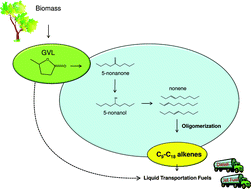Production of liquid hydrocarbon transportation fuels by oligomerization of biomass-derived C9 alkenes
Abstract
A process is described to produce renewable liquid

* Corresponding authors
a
University of Wisconsin-Madison, Department of Chemical and Biological Engineering, Madison, WI, USA
E-mail:
dumesic@engr.wisc.edu
Fax: +1 608 262 5434
A process is described to produce renewable liquid

 Please wait while we load your content...
Something went wrong. Try again?
Please wait while we load your content...
Something went wrong. Try again?
D. M. Alonso, J. Q. Bond, J. C. Serrano-Ruiz and J. A. Dumesic, Green Chem., 2010, 12, 992 DOI: 10.1039/C001899F
To request permission to reproduce material from this article, please go to the Copyright Clearance Center request page.
If you are an author contributing to an RSC publication, you do not need to request permission provided correct acknowledgement is given.
If you are the author of this article, you do not need to request permission to reproduce figures and diagrams provided correct acknowledgement is given. If you want to reproduce the whole article in a third-party publication (excluding your thesis/dissertation for which permission is not required) please go to the Copyright Clearance Center request page.
Read more about how to correctly acknowledge RSC content.
 Fetching data from CrossRef.
Fetching data from CrossRef.
This may take some time to load.
Loading related content
